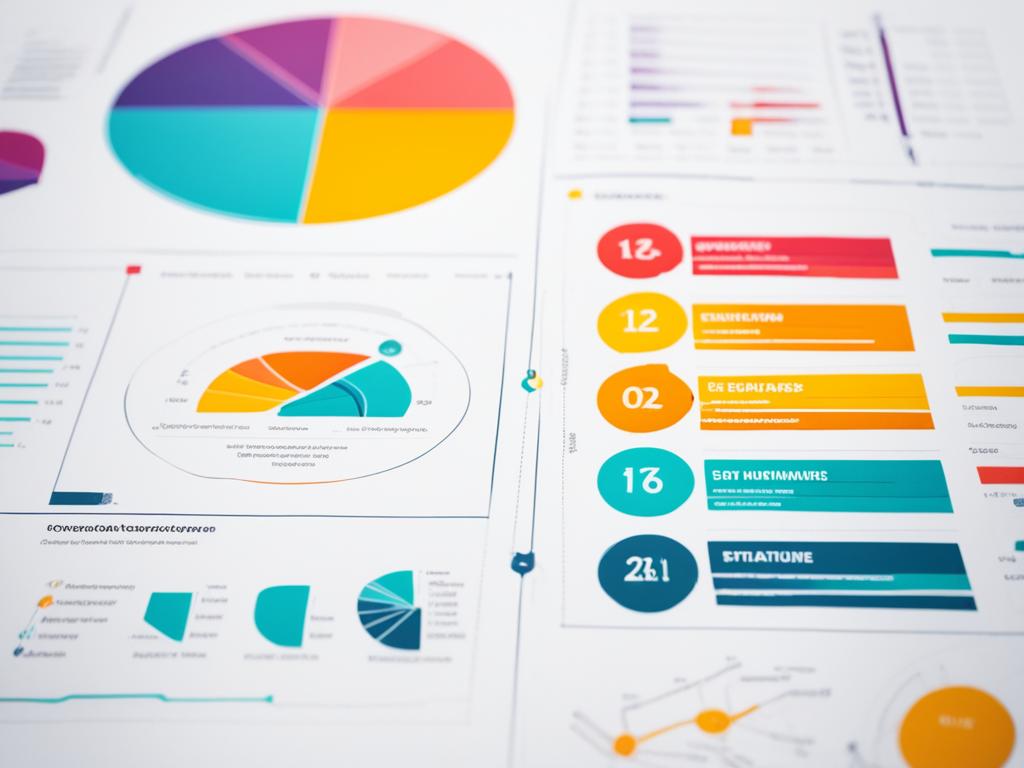Ever wondered what your website visitors do on your site? Are they easily finding what they want, or getting lost? It’s important to know how users behave to make your online space better. This is where Google Analytics shines. It helps us see what works and what doesn’t on our sites.
Google Analytics gives us key insights about our websites. It delves into data and metrics. This helps us really understand user interactions. And with this knowledge, we can tweak our sites to make them better for visitors.
So, how does Google Analytics work exactly? What stats should you look at to see if your site is doing well? And, most importantly, how do you turn this info into more sales and growth for your business? Let’s dive into how you can use Google Analytics. With it, you can significantly boost your website’s impact.
Key Takeaways:
- Google Analytics is a powerful tool for understanding user behavior on your website.
- Data analysis and website metrics are essential for improving online presence.
- By leveraging Google Analytics, you can optimize conversions and drive business growth.
- Understanding how users interact with your site is key to enhancing their experience.
- Google Analytics provides valuable insights that can help you make informed decisions.
Getting Started with Google Analytics
Google Analytics lets you understand user behavior and boost your website’s performance. It tracks how users interact with your site. With this information, businesses can make smart choices to grow and succeed online.
Tracking User Behavior for Informed Insights
Seeing how people use your site is key to knowing what actions to take. Google Analytics helps you see which pages are popular, where people leave your site, and more. Understanding this data lets you make your website better for visitors.
It helps answer questions like:
- Which pages have the highest bounce rate?
- What are the top exit pages?
- Which content drives the most engagement?
By finding these answers, you can make your website more welcoming and likely to lead to sales.
Optimizing Conversions for Increased Performance
Conversion optimization focuses on getting more visitors to do what you want, such as make a purchase. Google Analytics can track these actions. It shows how well your marketing is working at getting more sales or sign-ups.
Google Analytics offers several tools for optimizing conversions:
- Goal tracking: Set up goals to track specific actions on your website, like making a purchase.
- Funnel visualization: This shows where people leave your site in the sales process, so you can fix these areas.
- Multi-channel attribution: Understand which marketing channels get you the most sales. This helps you use your budget wisely.
In the end, better conversion means more profit from your marketing and a growing business.
We’ve covered why tracking user behavior and optimizing for conversions are key. Now, let’s learn how to effectively set up and use Google Analytics.
Analyzing Website Metrics with Google Analytics
To improve your website, you need to understand marketing analytics and where your traffic comes from. Google Analytics helps by offering insights and data for smarter business choices.
It lets you dive into your site’s performance and figure out what your visitors like. By knowing this, you can make your marketing more effective.
It’s crucial to know which sites or ads bring people to yours. Google Analytics can show if it’s from search engines, social media, links, or ads. This info helps you focus your efforts where they’re most useful.
Learning about your traffic sources can show you trends. You might see, for example, that a social media site is really popular for your visitors. Or, you might find ads that don’t do so well. This info is key to tweaking your strategies for better success.
“Analyzing website metrics through traffic source analysis is like having a compass to navigate the digital landscape. It guides your marketing efforts, helps you understand your target audience, and empowers you to make informed decisions.”
By understanding both marketing analytics and traffic sources, you see your site in a new light. This knowledge can help your marketing work better, find areas to boost, and increase your success.
Sample Traffic Source Analysis Table
| Traffic Source | Visits | Conversion Rate |
|---|---|---|
| Organic Search | 5,000 | 2.5% |
| Social Media | 2,500 | 3.2% |
| Referrals | 1,200 | 1.8% |
| Paid Advertising | 3,000 | 2.1% |
The table above shows how you can analyze your traffic sources. It helps you know where your visitors come from and which sources bring in more people. This can improve your marketing strategy.
Looking into your site’s metrics with Google Analytics can reveal important insights. These insights can shape your marketing, making you more successful online. By understanding and using analytics well, your business can grow significantly.
Audience Segmentation and Engagement Measurement
Knowing your audience and how they interact with your site is key for good marketing. Segmentation divides your audience into groups by their traits and interests. This helps you send the right message to each group and increase your success.
The Importance of Audience Segmentation
Not all customers are the same. Businesses have many people with different likes. By showing things each group likes, you make them feel special. This increases how often they buy from you.
Imagine you sell fashion online for men and women. You’d send men to see men’s products and women to see women’s products. This makes shopping more personal and fun for them.
Measuring Engagement Metrics
Measuring how people react to your content is very important. It tells you what works and what doesn’t. You then know what to change to do better.
Here are some important things to watch:
- Click-through rates (CTR): Measures how many people click on your links.
- Time on page: Shows how long people stay on a page, which can mean they like what they see.
- Bounce rate: The number of people who leave after seeing just one page. High bounce rates may mean something isn’t catching their interest.
- Social media shares and likes: Shows if people enjoy your content on social media.
- Conversion rates: The percentage of people who do what you want, like buy something or sign up.
By always checking these things, you can learn more about your audience. This helps you make smarter choices for your marketing.
Unlocking the Power of Audience Segmentation and Engagement Measurement
If you connect segmentation with tracking, you can make your marketing even better. You’ll understand what each group likes and doesn’t. Then you can send them things they really want to see. This increases how much they like your business and buy from you.
Remember, always check how well your strategies are doing. Make small changes as needed. This will keep helping you meet your audience well and grow your business.

| Segment | Engagement Metrics |
|---|---|
| Segment A: Age 18-24 | High social media engagement, low conversion rates on desktop |
| Segment B: Age 25-34 | Medium social media engagement, high conversion rates on mobile |
| Segment C: Age 35-44 | Low social media engagement, high conversion rates on desktop |
This example shows how understanding your audience is crucial. Segment A likes your social media but buys less on desktops. Make your online shop better for phones. Segment B buys a lot on mobile. So, focus your ads on phones. Segment C needs more targeted social media ads to buy more.
Visualizing Data with Google Analytics
Visualizing data is important for understanding and making decisions. Google Analytics offers many tools for this. These tools help businesses learn more about their websites and users.
The customizable dashboard is a key feature. It lets users make their own views of website data. These views can include traffic sources and user behaviors. The dashboard shows this data in charts and graphs.
Flow visualization in Google Analytics shows how visitors move through a site. It shows the path visitors take once they arrive. This can help businesses make their sites better and users happier.
Google Analytics also lets users compare different visitor groups. For example, they can compare new and returning visitors. This helps in tailoring marketing campaigns to suit each group better.
There’s also real-time reporting in Google Analytics. This shows updates on website performance instantly. Users can see things like active users and top pages. It helps in making quick changes when needed.
With Google Analytics, businesses can dive deep into their website’s data. They can use custom dashboards, analyze user flows, compare segments, and view real-time data. All this is vital for smarter decisions and site optimization.
Comparison of Google Analytics Data Visualization Tools
| Visualization Tool | Description |
|---|---|
| Customizable Dashboard | Create personalized visual representations of website metrics for a comprehensive view of data. |
| Flow Visualization | Visualize the flow of website visitors to improve website structure and user experience. |
| Segment Comparison | Compare different website segments to identify differences in user behavior and optimize marketing strategies. |
| Real-time Reporting | Track website performance in real-time with visual representations of active users, top pages, and traffic sources. |
Advanced Features and Tips for Google Analytics
Google Analytics is a key tool for checking website performance and learning about user behavior. This part looks at advanced features and tips. They’ll help you get more from your data.
1. Goal Tracking:
Goals in Google Analytics let you measure important actions or events on your site. You can see how well your marketing or pages are doing. This shows if you’re meeting your site’s goals.
2. Custom Segments:
Custom segments divide your visitors into different groups by traits or actions. This helps you see which groups do best. You can then change your marketing to focus on the most important ones.
3. Ecommerce Tracking:
Ecommerce tracking is vital for online shops. It lets you watch sales and profit. You can also see key numbers like average order value. This info is crucial for improving your shop and making customers happier.
4. Custom Reports:
You can make reports in Google Analytics that fit your needs. Pick the data you want to look at closely. This is great for tracking important goals or comparing different info.
5. Cross-Domain Tracking:
Cross-domain tracking is important if your site uses many domains. It lets you follow a user’s path across all parts of your site. This shows where users might get stuck before they finish something.
These advanced features and tips are there to help you get more from Google Analytics. They let you see your site’s performance in new ways. With these tools, you can make smarter choices for your business.
Conclusion
We’ve learned a lot about Google Analytics in this article. It’s a key tool for understanding websites better. With it, businesses can see how users interact with their site. This helps them make smarter choices to enhance their online presence.
Google Analytics makes diving into data fun and critical for success. It tracks how users move through websites and checks important numbers. This way, companies spot where they can do better. They can then use smart plans to improve, helping to boost sales and meet their aims.
Thanks to Google Analytics, knowing who’s engaging with a site becomes easier. This tool lets businesses divide their visitors into groups. They can then fine-tune their marketing to grab more attention and set strategies that work. It also shows what really pulls people in, leading to more sales.
Seeing data visually is key to understanding it well. Google Analytics offers different ways to show data, which is great for spotting trends. Such visual clues help companies make the best decisions. It fine-tunes their marketing so it performs better overall.
In ending, using Google Analytics is a must for those wanting to do well online. By watching data, judging engagement, and using all of Google Analytics advanced tools, companies get to know their audience deeply. This leads to better user experiences and more sales.




